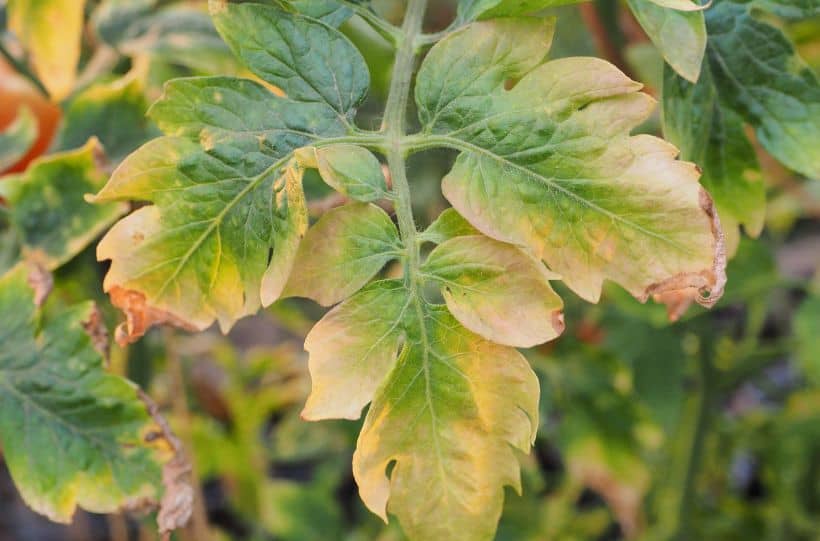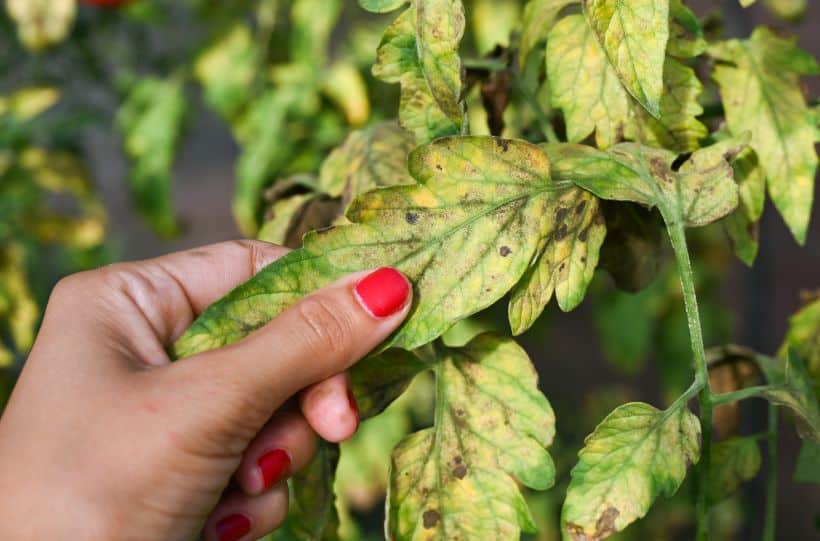Yellow Tomato Leaves – Why Your Tomatoes Leaves are Turning Yellow or Brown
Sometimes gardening doesn’t go as well as we planned and we have issues with things like yellowing and browning of tomato leaves that can leave your plants looking rough and even mean the end of your crop.
The good news is that most of the time your plants can be saved. When they can not, the best course of action is to simply burn the plants after pulling them and make use of the garden space in another way.

Why it is Important to Check Your Tomatoes Leaves
The leaves of your tomato plants can be very telling about what your plant needs. From a lack of water to pest control your plant’s leaves will show any damage or the effects of something wrong at a deeper level.
Checking your tomato plant leaves on a daily basis when checking on and watering your garden can allow you to catch problems right away and help keep your garden as healthy as possible.
When out in your garden take the time to observe and even flip a few leaves on your tomato plants to check for signs of major issues so you can care for them right away. This can help your plants survive nearly anything simply by giving you the opportunity to act fast.
Why Your Tomatoes Leaves are Turning Yellow or Brown
There are a few reasons that your tomato leaves may be turning brown or yellow. These can range from simply not getting enough of what they need to possible damage from pests and disease.
Water
If you have had a lot of heat or haven’t been watering your tomatoes you may see that they have turned yellow or brown. This is common after gardeners go on vacation and do not have someone to look after their plants even for just a few days in the heat of the summer.
The good news is that plants can bounce back from this as long as it is not too much of the plant that has been damaged. Checking your tomato leaves often will allow you to catch them when they are curling before they begin to yellow and brown.
Nutrition
When your tomatoes suddenly start to yellow and brown it is often due to issues with the nutrition of your soil. This can be from not having enough for many different nutrients from calcium to potassium or simply not having enough acid to allow your tomatoes to pick up the nutrition from the soil.
The best course of action for this is to start by checking the PH level of your soil. This will let you know if your soil is too acidic or not acidic enough. Tomatoes thrive at a PH balance of 5.5 to 7.5.
If your soil is not at the right PH level you can easily amend the soil to help improve the PH level so your plants can obtain the nutrition they need to thrive.
This is a common issue in the soil that leads to your plants not being able to absorb the nutrients from the soil. This can lead to issues with being able to absorb essential nutrients like calcium that prevent another common tomato issue called blossom end rot.
To quickly improve the acidity of your soil try adding sulfur or even everyday high acid items like coffee grounds.
If your soil PH levels are in the right range odds are you are lacking in another common nutrient. This can easily be fixed by using a fresh compost tea or a fertilizer designed to meet the nutritional needs of tomatoes. One popular option is to buy rabbit poop to use as a fertilizer in your garden.
Disease
There are several mosaic viruses that can cause the yellowing of tomato plant leaves. Most diseases found in tomato plants can not be cured and it is best to pull up the plants and burn them to stop the spread of the virus.
When planting in the following year avoid planting tomatoes or other plants from the same family in that garden bed to prevent issues with the virus from coming back for a second year.
Salt Damage
Many gardeners are using salt as a weed killer as a natural option. This commonly kills off other plants in the same area.
If you suspect salt damage is the issue for your tomatoes, leaching is often the easiest way to help reduce the salt concentration in your soil this is done by consistently flooding your garden to work the salt down deeper and out of your garden beds.
Watering daily can help to achieve this. But because salts are not the only compounds that will work their way out of the soil, be sure to take the time to add fresh compost or fertilizer to help provide your plants with nutrition.

And for more tomato growing guides, be sure to read these next:

